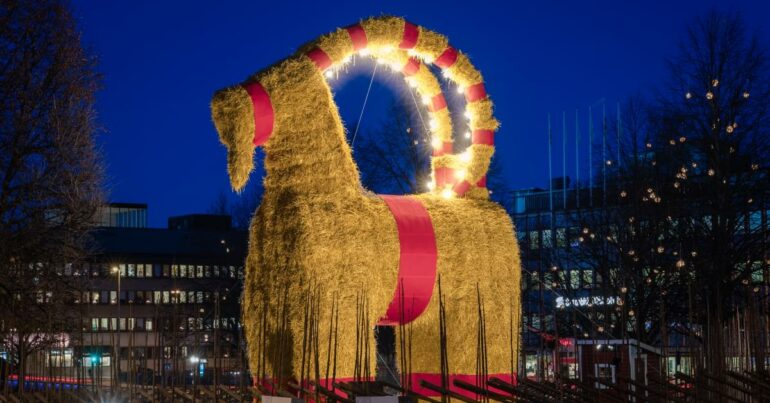
Some Christmas traditions remain the same no matter where you live, like singing, eating, giving gifts and decorating a Christmas tree.
However, some Christmas traditions around the world may surprise you. From evil witches to burning devils, many cultures are still incorporating local legends of folklore to Christmas spirit.
Read below, where you’ll discover just how different these holiday traditions are. You might just learn some fun trivia to bring to your next family gathering!
1. Japan – Christmas KFC
Most countries see the holiday season as a time of gathering and may have a tradition of getting together to enjoy a Christmas meal. This is also true in Japan. Christmas is a recent Western import to the largely non-Christian Japan.The Japanese have only just started to start to celebrate the holiday in the past few decades.
In Japan, the Christmas food of choice is KFC. The tradition of eating KFC for Christmas goes back to a marketing campaign in 1974. To this day, KFC records the highest sales volume each year on Christmas Eve.
2. Ukraine – Lucky spider webs
Most imagine Christmas trees decorated with lights and brightly coloured ornaments. Some go as far as to cover their houses in neon lights and happy, festive sculptures!
However, in Ukraine, they tell the legend of the Christmas Spider, in which a poor woman and her children wake up on Christmas Eve to find a tree growing in their tiny home, covered in spider webs. When they woke up again on Christmas day, the webs had turned to gold and silver.
This is why you will see Ukrainians decorate their Christmas tree with a spider web. It’s believed that the webs will bring good fortune and luck for the upcoming year. Similar tales can be heard in nearby countries. For example, in Germany, finding a spider on your Christmas tree is also a sign of good luck.
3. Italy – The legend of La Befana
Many cultures recognize Santa Claus as the Christmas mascot, travelling around the world and delivering gifts to deserving young boys and girls on the night of Christmas Eve.
But in Italy, there’s also a mythical figure who travels the world, sorting good children from bad and delivering gifts: La Befana.
According to folklore, the old lady ignored an invitation from the Three Wise Men to witness the birth of Christ, and was so devastated about missing it, she spends every Christmas flying around the country searching for Baby Jesus.
Befana travels around Italy on Epiphany Eve (the night of 5th January), filling socks with candy for the good children and giving nothing but a lump of coal to the naughty ones!
4. Austria – Krampus, the Christmas devil
Austria’s version of Christmas tradition includes the evil Krampus, who roams the city streets looking for poorly behaved children on Christmas Eve.
In Austrian tradition, children place a shoe in front of their house on 5th December and St. Nicholas rewards nice little boys and girls, filling them with treats.
Meanwhile, Krampus catches the naughtiest children and whisks them away in his sack, never to be seen again. In the first week of December, in certain parts of Austria, people dress up as Krampus, scaring children with clattering chains and bells.
5. Iceland – The Yule Lads
In Iceland, during the 13 days leading up to Christmas, 13 gnome-like characters are said to come to visit the children across the country. These harmless pranksters are also called the ‘Icelandic Santas’. They are friendly to well-behaved children.
Each night of Yuletide, children place their best shoes by the window and a different ‘Yule Lad’ leaves them gifts. It can be a small toy, a piece of candy, or a healthier choice like a mandarin orange. Those that haven’t behaved get a rotten potato and need to step up their game before the next Yule-lad shows up.
6. Sweden – The Yule Goat
Swedish legend has it that Santa would ride the Yule goat instead of his sleigh to help deliver presents.
Other stories tell of the Yule goat as an invisible spirit who appears right before Christmas to help with preparations. The goat is most commonly depicted as a little Christmas ornament made of straw and tied with red ribbon.
However, in the town of Gävle, Sweden, a 42-foot high straw goat statue is built every year in the square, about a month before Christmas. Soon after the tradition began, local pranksters began to burn it down each year. Now, burning the goat made of straws has become part of the event.
7. Christmas, USA – All-year Christmas
It’s always a jolly time in the town of Christmas, Florida. Tourists flock here to get their holiday cards and letters stamped at the post office, so recipients can receive special letters sent from ‘Christmas, FL’!
Street names are Christmas-themed, including Bethlehem Street, Comet Street, Cupid Avenue and St. Nicholas Avenue.
To top it off, it’s the town’s favourite tradition to display a decorated, evergreen Christmas tree all year round in the city square.
8. Guatemala – La Quema del Diablo
In Guatemala, local traditions say the devil and other evil spirits live in the dark, dirty corners of your home.
Therefore, they spend the week before Christmas sweeping up, collecting rubbish and then piling everything in a huge heap outside. Finally, an effigy of the devil is placed on top, and the whole thing is set on fire.
It’s called La Quema del Diablo, the ‘Burning of the Devil’. The idea for Guatemalans is to burn all the bad from the previous year so that a new year can be born from the ashes.
9. Wales – Mari Lwyd
The Mari Lwyd is a Celtic tradition from South Wales. Mari Lwyd translates to ‘Grey Mare.’ Thought to have originated from Celtic Mythology, the pale horse is thought to be able to pass to the underworld. During the celebration, groups of locals parade the skeletal remains of a horse through the town, stopping by people’s front doors along the way.
The group knocks on the doors of local residents and sings for them. Sometimes they’ll challenge others to a rhyming game, a riddle or a game of wits. In return, they are offered food, drink, and perhaps a song in return.
10. Mexico – Posadas
In Mexico, from 16th December to Christmas Eve, children perform the ‘posadas,’ a series of nine plays or processions which re-enact the part of the Christmas story of Joseph and Mary.
On the final night of the posadas, a Church service featuring food, games and fireworks is held. These services almost always include pinatas – a decorated papier-mache container filled with sweets. Children take it in turns to whack the suspended pinata while blindfolded until it breaks and the sweets fall out.
Matthew Swaile
Copywriter
Florence Couëdel
Editor









